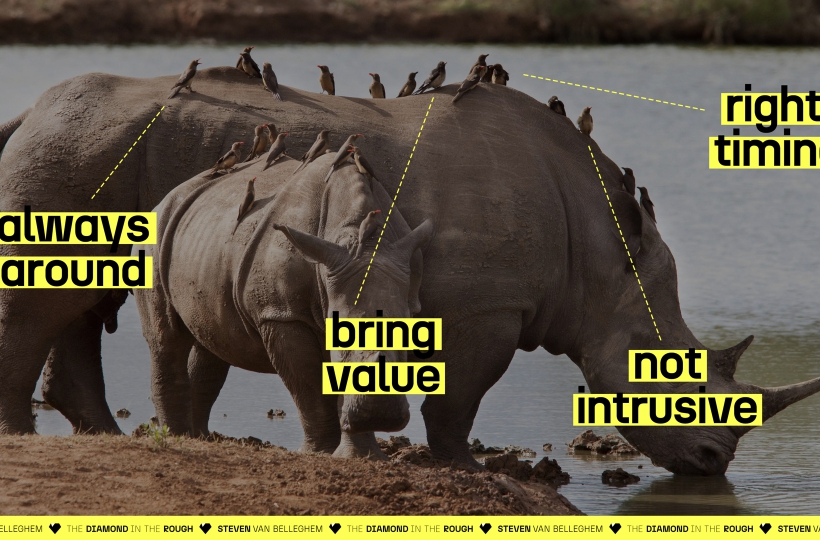My favourite customer experience metaphor ever: The Oxpecker and the Rhino

In my last book, The Offer You Can’t Refuse, I described how companies ought to invest in three different axes – on top of offering a great product or service, obviously, which is a given – in order to be able to react in an appropriate manner to the new generation of customer expectations:
- Ultimate Convenience: this is the use of new technology in a smart way in order to make interfaces ever more automated, so that the customer needs to make no effort to do business with your company. This leads to the perfect transactional relationship.
- Partner in Life: this is not about your customer journey, but about the life journey of your customer. Which aspects in the lives of your customers create negative or positive energy? What things cost them too much effort? If you can provide answers to these questions, you can optimise your emotional relationship with your customers.
- Save the World: this is about companies taking their responsibility to do good for society as a whole. Every company has strengths that it can use to create a societal added value. Search for concrete solutions and contributions that will allow your company to make a truly tangible impact.
Today, I want to focus on that Partner in Life part. My customers and listeners are always very curious about that, about how they can help their customers achieve their hopes and dreams. And I love to give them examples of companies who excelled at becoming a Partner in Life. Like Spotify that helped its customers share their musical passion, Samsung’s smart fridge that becomes a partner in setting the family diet or insurer Centraal Beheer and their Handyman app.
But I think that perhaps my favourite way ever to explain the Partner in Life concept is through the metaphor of the amazing symbiosis of the rhino and the oxpecker. Rhinos are very literally a force of nature. When a lion bumps into one, it probably thinks something along the lines of “Oh no, we’re not going to do that. Let’s just look from some zebras or something.” Lions, and other predators are too smart to attack a healthy rhinoceros, unless it’s maybe an old or injured one.
But because rhinos have very few natural enemies, they did not get all the premium safety features. For instance, they do not have the best eyesight, nor do they have the best smelling capabilities. And unfortunately, because of that, a rhino is an easy victim for poachers.
But the rhino also has a partner in life: the oxpecker. At first sight, these are pretty boring looking birds (except for their colorful beaks) that have the habit of perching on large mammals like cattle, zebras, impalas, hippopotamuses, giraffes, and of course … rhinoceroses. They eat ticks, small insects, larvae, and other parasites from their hosts. But the best part is that they also function as an alarm system: having great eyesight, they can spot humans from a pretty big distance. And when they see them, they make a certain type of sound, alarming rhinos to the fact that the humans are coming, allowing them to run away in time.
The oxpecker on the back of the rhino is the absolute perfect metaphor for my Partner in Life concept. That’s exactly what your customer expects from you as a life partner: that you’re always around and that you bring value at the exact right moment, but without being intrusive.
So four things:
- Be always around
- But do NOT be intrusive
- Bring value
- At the right moment
And you have to take into account all four of these. Because you’re at risk of being perceived as annoying and intrusive if you are only around all the time. That’s a very dangerous strategy. I used to compare that to the fly on the back of the cow, which are indeed always around in the summer, but also don’t bring any value whatsoever and are very intrusive. But, lately, I’ve been thinking I might perhaps use an even more radical metaphor, that of parasitism versus the symbiosis-like relationship of the rhino and the oxpecker. The latter relationship is mutually beneficial, while parasites are known to only take and not give back. They extract value rather than provide it.
A perfect example would be the mistletoe – which we all know from the Christmas tradition – and its host, the tree. Mistletoes derive their water and nutrients from their host and don’t actually bring anything useful to the table. They rarely truly harm their trees (wouldn’t be smart to bite the hand that feeds you), but they do not help them either. And when you think about it, that is the relationship that still too many companies have with their customers: a purely transactional relationship, where (almost) all the value is for company, rather than for the customer. Of course, the customer gets a product or a service in exchange for money, but that’s just a given. The company gets so much more value out of the relationship.
So if you want to be successful in CX, make sure that you bring more value to the table. Don’t extract, but generate value. Don’t just give something in return for money. Be a real partner in life. Be an oxpecker. And do that in an unobtrusive way.